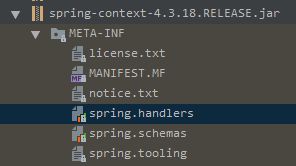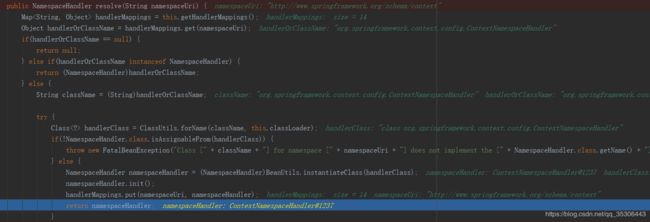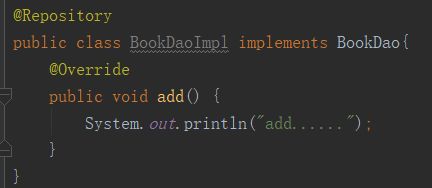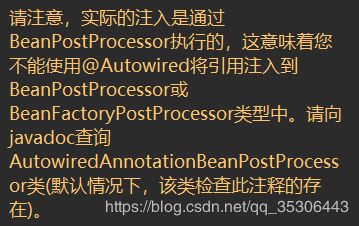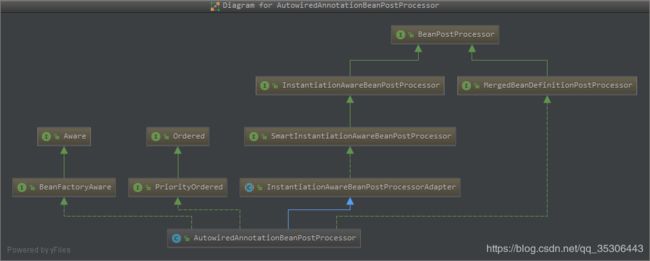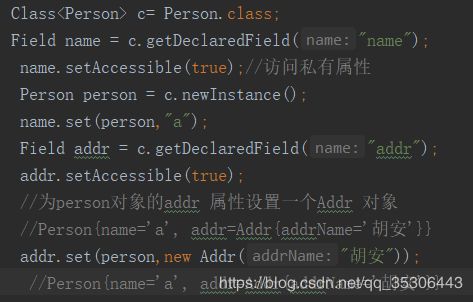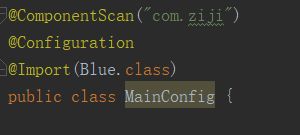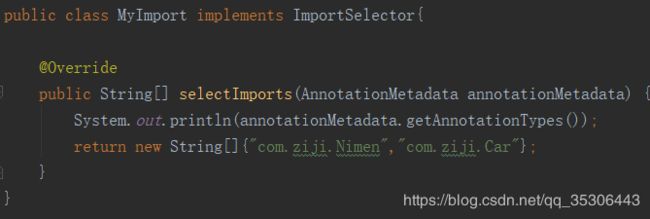@Component,@service,@autowired等注解的实现原理
默认情况下bean Name的默认生成策略;
@component @service @Controller @Respository
入口肯定是BeanNameGenerator接口声明的generateBeanName(BeanDefinition,BeanDefinitionRegistry)方法,该方法做了一个分类判断,处理AnnotationBeanDefinition和DefaultBeanNameGenerator两种方式的。这里只看注解方式。
public interface BeanNameGenerator {
String generateBeanName(BeanDefinition var1, BeanDefinitionRegistry var2);
}AnnotationBeanDefinition.java
public class AnnotationBeanNameGenerator implements BeanNameGenerator {
private static final String COMPONENT_ANNOTATION_CLASSNAME = "org.springframework.stereotype.Component";
@Override
public String generateBeanName(BeanDefinition definition, BeanDefinitionRegistry registry) {
// 判断是AnnotatedBeanDefinition的实现,就从annotation获得。
if (definition instanceof AnnotatedBeanDefinition) {
String beanName = determineBeanNameFromAnnotation((AnnotatedBeanDefinition) definition);
// 是文本就返回这个beanName,但是也有可能annotation的value是null,就后从buildDefaultBeanName获得
if (StringUtils.hasText(beanName)) {
return beanName;
}
}
return buildDefaultBeanName(definition, registry);
}
protected String determineBeanNameFromAnnotation(AnnotatedBeanDefinition annotatedDef) {
// 获得类或者方法上所有的Annotation
AnnotationMetadata amd = annotatedDef.getMetadata();
// 得到所有annotation的类名
Set types = amd.getAnnotationTypes();
String beanName = null;
for (String type : types) {
// 把annotation里面的字段与value,解读出来成map,字段名是key,value为value
AnnotationAttributes attributes = AnnotationConfigUtils.attributesFor(amd, type);
// 判断annotation是否有效,是否存在作为beanName的字段有value
if (isStereotypeWithNameValue(type, amd.getMetaAnnotationTypes(type), attributes)) {
// 从注解中获得value字段的值,
Object value = attributes.get("value");
if (value instanceof String) {
String strVal = (String) value;
if (StringUtils.hasLength(strVal)) {
if (beanName != null && !strVal.equals(beanName)) {
throw new IllegalStateException("Stereotype annotations suggest inconsistent " +"component names: '" + beanName + "' versus '" + strVal + "'");
}
beanName = strVal;
}
}
}
}
return beanName;
}
protected boolean isStereotypeWithNameValue(String annotationType,Set metaAnnotationTypes, Map attributes) {
// 判断annotation的类型是否是这三种.
// org.springframework.stereotype.Component
// javax.annotation.ManagedBean
// javax.inject.Named
boolean isStereotype = annotationType.equals(COMPONENT_ANNOTATION_CLASSNAME) ||
(metaAnnotationTypes != null && metaAnnotationTypes.contains(COMPONENT_ANNOTATION_CLASSNAME)) ||
annotationType.equals("javax.annotation.ManagedBean") ||
annotationType.equals("javax.inject.Named");
// 并且value存在值。才会返回true
return (isStereotype && attributes != null && attributes.containsKey("value"));
}
protected String buildDefaultBeanName(BeanDefinition definition, BeanDefinitionRegistry registry) {
return buildDefaultBeanName(definition);
}
protected String buildDefaultBeanName(BeanDefinition definition) {
// 获得类名
String shortClassName = ClassUtils.getShortName(definition.getBeanClassName());
// 把类名第一个字母大写转小写
return Introspector.decapitalize(shortClassName);
}
} debug测试:容器启动就开始注册bean
然后进入到红色箭头指向的地方
这里MconfiAop转为mconfiAop
以后注册进入容器中的beanName
默认的都是类名第一个字母小写,
不是默认策略就是value;里面的值value作为beanName
-------------------------------------------------- -------------------------------------------------- -----------
包扫描注册豆的原理分析
![]()
@service @Controller @Respository注解上面都标注了@Component注解它们之间是等效的
只是为了分层标注
@Component的实现原理:
我们知道它们是向IOC容器中注册beanDefiniton,而背景是自定义标签根据之前讲解的自定义标签解析
我们知道自定义标签的解析为如下方法DefaultBeanDefinitionDocumentReader.java
![]()
解析自定义标签的时候首先需要获得XML中名称空间BeanDefinitionParserDelegate.java
String namespaceUri = this.getNamespaceURI(ele);//xmlns:context="http://www.springframework.org/schema/context"然后根据名称空间找到对应的找到对应的NameSpaceHandler来进行处理
NamespaceHandler handler = this.readerContext.getNamespaceHandlerResolver().resolve(namespaceUri);默认在/ META-INF下spring.handler
![]()
我们最终找到了ContextNamespaceHandler
public class ContextNamespaceHandler extends NamespaceHandlerSupport {
public void init() {
this.registerBeanDefinitionParser("property-placeholder", new PropertyPlaceholderBeanDefinitionParser());
this.registerBeanDefinitionParser("property-override", new PropertyOverrideBeanDefinitionParser());
this.registerBeanDefinitionParser("annotation-config", new AnnotationConfigBeanDefinitionParser());
this.registerBeanDefinitionParser("component-scan", new ComponentScanBeanDefinitionParser());
。。。。。。。}
这段代码中注册了许多解析器,我们重点关注ComponentScanBeanDefinitionParser
锁定解析()方法
public BeanDefinition parse(Element element, ParserContext parserContext) {
String basePackage = element.getAttribute(BASE_PACKAGE_ATTRIBUTE); // 获取base-package属性
basePackage = parserContext.getReaderContext().getEnvironment().resolvePlaceholders(basePackage); // 处理包路径 中的特殊符号,如${}
// 分割
String[] basePackages = StringUtils.tokenizeToStringArray(basePackage,
ConfigurableApplicationContext.CONFIG_LOCATION_DELIMITERS);
/* 配置Scanner */
ClassPathBeanDefinitionScanner scanner = configureScanner(parserContext, element);
/* 扫描 */
Set beanDefinitions = scanner.doScan(basePackages);
/* 注册一些注解相关的PostProcessor,将BeanDefinition注册完成的事件通知给相关监听器 */
registerComponents(parserContext.getReaderContext(), beanDefinitions, element);
return null;
} ![]()
protected ClassPathBeanDefinitionScanner createScanner(XmlReaderContext readerContext, boolean useDefaultFilters) {
return new ClassPathBeanDefinitionScanner(readerContext.getRegistry(), useDefaultFilters, readerContext.getEnvironment(), readerContext.getResourceLoader());
}直到 ClassPathScanningCandidateComponentProvider.java![]()
protected void registerDefaultFilters(){
//添加默认的组件注解的过滤器
this.includeFilters.add(new AnnotationTypeFilter(Component.class));
ClassLoader cl = ClassPathScanningCandidateComponentProvider.class.getClassLoader();
}
我们看到了默认的@Component注解过滤器的添加,而我们常用的@服务,@控制器等注解都使用了@Component注解,所以同样会匹配这个过滤器。
protected Set
Assert.notEmpty(basePackages,“必须至少指定一个基本包”);
设置
for(String basePackage:basePackages){
/ *获取候选的BeanDefinition * /
Set
for(BeanDefinition candidate:candidate){
/ *处理@Scope注解元数据* /
ScopeMetadata scopeMetadata = this.scopeMetadataResolver.resolveScopeMetadata(candidate);
candidate.setScope(scopeMetadata.getScopeName());
//生成beanName
String beanName = this.beanNameGenerator.generateBeanName(candidate,this.registry);
if(候选instanceof AbstractBeanDefinition){
postProcessBeanDefinition((AbstractBeanDefinition)candidate,beanName);
}
如果(候选的instanceof AnnotatedBeanDefinition){
//其他注解的处理
AnnotationConfigUtils.processCommonDefinitionAnnotations((AnnotatedBeanDefinition)候选);
}
//检查BeanDefinition
if(checkCandidate(beanName,candidate)){
BeanDefinitionHolder definitionHolder = new BeanDefinitionHolder(candidate,beanName);
definitionHolder =
AnnotationConfigUtils.applyScopedProxyMode(scopeMetadata,definitionHolder,this.registry);
beanDefinitions.add(definitionHolder);
//注册BeanDefinition
registerBeanDefinition(definitionHolder,this.registry);
}
}
}
返回的BeanDefinitions;
findCandidateComponents()方法会获取basePackage的值
![]() 里面的isCandidateComponent()方法用来过滤之前添加的过滤器过滤资源
里面的isCandidateComponent()方法用来过滤之前添加的过滤器过滤资源
protected boolean isCandidateComponent(MetadataReader metadataReader)throws IOException {
// excludeFilter过滤
for(TypeFilter tf:this.excludeFilters){
if(tf.match(metadataReader,this.metadataReaderFactory)){
return false;
}
}
//
includeFilter 过滤for(TypeFilter tf:this.includeFilters){
if(tf.match(metadataReader,this.metadataReaderFactory)){
// @Conditional注解解析和判断
return isConditionMatch(metadataReader);
}
}
返回false;
}
默认情况excludeFilters是空的,includeFilters包含之前添加的@Component注解的AnnotationTypeFilter,所以这里会过滤掉不包含@Component注解的类。然后就是生成beanDifiniton和注册beanDefinition
@Autowired
我们知道在整合SSM项目中我们一般是在实现类上加上@Component等组件,但是我们使用@Autowired注解注入的时候其实注入得是类型的接口下面看看演示:
如果使用@resource需要改变注入到beanName ---按名称装配
在@Autowired的定义中有下面一段话:链接
Note that actual injection is performed through a BeanPostProcessor
which in turn means that you cannot use @Autowired to inject references into BeanPostProcessor
or BeanFactoryPostProcessor types.
Please consult the javadoc for the AutowiredAnnotationBeanPostProcessor class
(which, by default, checks for the presence of this annotation).
有图可知AutowiredAnnotationBeanPostProcessor实现了BeanPostProcessor的,IOC容器启动时候@Autowired注解会工作
@autowired注释会自动装配按类型
这种类型有多个则会按照注册的属相值作为id注入:容器中有两个UserDao类型userdao1 userdao2,@ UserDao userdao2
则注入的userdao2类型加上@Qualifier( “userdao1”):使用@Qualifier指定需要装配的组件的ID,而不是使用属性名,明确指定使用userdao1自动装配默认一定要将属性赋值好,没有就会报错;可以使用@Autowired(required = false);
@Primary:让春天进行自动装配的时候,默认使用首选的豆;
下面看看原理:我们知道AutowiredAnnotationBeanPostProcessor实现的,查看该类的源码会发现它实现了MergedBeanDefinitionPostProcessor接口,进而实现了接口中的postProcessMergedBeanDefinition方法。
来源
根据对Spring源码的分析我们知道BeanPostProcessor原理在对豆的实例化和初始化时AbstractAutowireCapableBeanFactory.java中的doCreateBean方法中有这样一段代码
synchronized(mbd.postProcessingLock) {
if(!mbd.postProcessed) {
try {
this.applyMergedBeanDefinitionPostProcessors(mbd, beanType, beanName);
} catch (Throwable var17) {
throw new BeanCreationException(mbd.getResourceDescription(), beanName, "Post-processing of merged bean definition failed", var17);
}
mbd.postProcessed = true;
}
}
在这段代码中会执行applyMergedBeanDefinitionPostProcessors(mbd,beanType,beanName),深入这段代码又会执行postProcessMergedBeanDefinition
protected void applyMergedBeanDefinitionPostProcessors(RootBeanDefinition mbd, Class beanType, String beanName) {
Iterator var4 = this.getBeanPostProcessors().iterator();
while(var4.hasNext()) {
BeanPostProcessor bp = (BeanPostProcessor)var4.next();
if(bp instanceof MergedBeanDefinitionPostProcessor) {
MergedBeanDefinitionPostProcessor bdp = (MergedBeanDefinitionPostProcessor)bp;
bdp.postProcessMergedBeanDefinition(mbd, beanType, beanName);
}
}
}
接口
public interface MergedBeanDefinitionPostProcessor extends BeanPostProcessor {
void postProcessMergedBeanDefinition(RootBeanDefinition var1, Class var2, String var3);
}
实现类
public class AutowiredAnnotationBeanPostProcessor extends InstantiationAwareBeanPostProcessorAdapter implements MergedBeanDefinitionPostProcessor, PriorityOrdered, BeanFactoryAware {
。。。。。。
public void postProcessMergedBeanDefinition(RootBeanDefinition beanDefinition, Class beanType, String beanName) {
if(beanType != null) {
//找到@autowired注解
InjectionMetadata metadata = this.findAutowiringMetadata(beanName, beanType, (PropertyValues)null);
metadata.checkConfigMembers(beanDefinition);
}
}
。。。。。。。
}上述信息:找到beanName(也重要)
如何找到策略有疑惑
![]()
![]()
AnnotationAttributes ann = AutowiredAnnotationBeanPostProcessor.this.findAutowiredAnnotation(bridgedMethod);
//找到所有的注解方法
private AnnotationAttributes findAutowiredAnnotation(AccessibleObject ao) {
if(ao.getAnnotations().length > 0) {
//遍历所有的@autowired注解类型
Iterator var2 = this.autowiredAnnotationTypes.iterator();
while(var2.hasNext()) {
Class type = (Class)var2.next();
AnnotationAttributes attributes = AnnotatedElementUtils.getMergedAnnotationAttributes(ao, type);
if(attributes != null) {
return attributes;
}
}
}
同样,在doCreateBean方法中执行populateBean方法实现对属性的注入。
这段代码中会遍历所有注册过的BeanPostProcessor的接口实现类的实例,如果实例属于InstantiationAwareBeanPostProcessor类型的,则执行实例类的postProcessPropertyValues方法.AutowiredAnnotationBeanPostProcessor继承了InstantiationAwareBeanPostProcessorAdapter,而AutowiredAnnotationBeanPostProcessor间接实现了InstantiationAwareBeanPostProcessor接口,所以这里会执行到AutowiredAnnotationBeanPostProcessor类的postProcessPropertyValues方法,具体代码如下。
findAutowiringMetadata方法获取该bean的InjectionMetadata实例(也就是有哪些属性需要被自动装配,也就是查找被@Autowired注解标记的元素)
metadata.inject(bean,beanName,pvs)代码的执行会进入如下注入方法中,在这里完成依赖的注入。
AutowiredAnnotationBeanPostProcessor.java
protected void inject(Object bean, String beanName, PropertyValues pvs) throws Throwable {
Field field = (Field)this.member;//bookDao1
Object value;
if(this.cached) {
value = AutowiredAnnotationBeanPostProcessor.this.resolvedCachedArgument(beanName, this.cachedFieldValue);
} else {
DependencyDescriptor desc = new DependencyDescriptor(field, this.required);
desc.setContainingClass(bean.getClass());
Set autowiredBeanNames = new LinkedHashSet(1);
TypeConverter typeConverter = AutowiredAnnotationBeanPostProcessor.this.beanFactory.getTypeConverter();
try {
value = AutowiredAnnotationBeanPostProcessor.this.beanFactory.resolveDependency(desc, beanName, autowiredBeanNames, typeConverter);
} catch (BeansException var12) {
throw new UnsatisfiedDependencyException((String)null, beanName, new InjectionPoint(field), var12);
}
synchronized(this) {
if(!this.cached) {
if(value == null && !this.required) {
this.cachedFieldValue = null;
} else {
this.cachedFieldValue = desc;
AutowiredAnnotationBeanPostProcessor.this.registerDependentBeans(beanName, autowiredBeanNames);
if(autowiredBeanNames.size() == 1) {
String autowiredBeanName = (String)autowiredBeanNames.iterator().next();
if(AutowiredAnnotationBeanPostProcessor.this.beanFactory.containsBean(autowiredBeanName) && AutowiredAnnotationBeanPostProcessor.this.beanFactory.isTypeMatch(autowiredBeanName, field.getType())) {
this.cachedFieldValue = new AutowiredAnnotationBeanPostProcessor.ShortcutDependencyDescriptor(desc, autowiredBeanName, field.getType());
}
}
}
this.cached = true;
}
}
}
if(value != null) {
ReflectionUtils.makeAccessible(field);
field.set(bean, value);
}
}
} ![]()
![]()
![]()
嗯关键的一步是BookDaoImpl怎么找到的,我看看。调试了三个小时终于找到真正得到BookDaoimpl的地方,非常精彩
使用spring特有的通过getBean方法传入beanName和接口类型得到然后放到map中,之后从map中的到key和value
最后实现上面的注册。
直接从注入的缓存中那个通过BeanName得到对象(实现类)
上述的bean当于XML
![]()
protected void inject(Object bean, String beanName, PropertyValues pvs) throws Throwable {value = AutowiredAnnotationBeanPostProcessor.this.beanFactory.resolveDependency(desc, beanName, autowiredBeanNames, typeConverter);//这个方法会返回BookDaoimpl
}意思为:BookDao1字段设置一个BookDaoImpl对象的值,相似代码如下:
流程1读取所有bean,2实例化bean,3为字段设置值
原理总结:就是给BookServeimpl(实现类)中的属性bookDao1注入一个实现类(相当于new对象实例化)
在setter方法注入原理相当于调用method.invoke(bean,value)方法
bean相当于BookServiceImpl对象,值表示BookService类里面BookDao对象的属性
666666666完结撒花
----------------------------------
链接拓展
Spring Import三种用法与源码解读
继续:
我们知道可以通过@import注解导入组件,只能加载类上
(1)注册了蓝组件
还可以通过ImportSelector注入组件和使用ImportBeanDefinitionRegistrar注册
(2)注册了Nimen和Car组件
(3)注册了黄色这个组件
(2),(3)需要使用进口标签
我们知道进口标签是朝春容器中注册组件,春季注册豆是在初始化之前
ConfigurationClassPostProcessor实现了BeanDefinitionRegistryPostProcessor,BeanDefinitionRegistryPostProcessor
继承了BeanFactoryPostProcessorpublic interface BeanDefinitionRegistryPostProcessor extends BeanFactoryPostProcessor {
void postProcessBeanDefinitionRegistry(BeanDefinitionRegistry var1) throws BeansException;
}源码分析
public void postProcessBeanDefinitionRegistry(BeanDefinitionRegistry registry) {
int registryId = System.identityHashCode(registry);
if(this.registriesPostProcessed.contains(Integer.valueOf(registryId))) {
throw new IllegalStateException("postProcessBeanDefinitionRegistry already called on this post-processor against " + registry);
} else if(this.factoriesPostProcessed.contains(Integer.valueOf(registryId))) {
throw new IllegalStateException("postProcessBeanFactory already called on this post-processor against " + registry);
} else {
this.registriesPostProcessed.add(Integer.valueOf(registryId));
this.processConfigBeanDefinitions(registry);
}
}this.processConfigBeanDefinitions()方法:处理配置配置
ConfigurationClassParser.java解析@import标签




